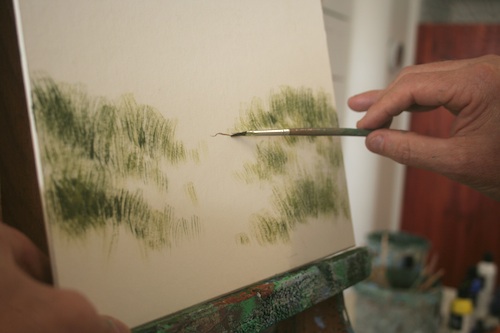Discover and Mastering the Dry Brush Technique in Art – The world of art is rich with various techniques that artists use to achieve unique and captivating effects in their creations. One such technique is the dry brush technique, which adds texture and depth to artworks through controlled and deliberate brushwork. In this article, we delve into the dry brush technique in art, exploring its advantages, comparing it with wet brush techniques, and uncovering how artists create its distinctive effects.
Understanding the Dry Brush Technique in Art
The dry brush technique involves using a brush with minimal paint and applying it to the canvas with a light touch. Unlike traditional painting techniques, where the brush is loaded with paint, the dry brush technique uses only a small amount of paint, creating a scratchy and textured appearance. This technique allows artists to achieve intricate details, fine lines, and a variety of textures, making it a popular choice for adding depth and realism to various subjects. daftar premium303
Benefits of Dry Brush Painting
- Texture Enhancement: The dry brush technique is renowned for its ability to enhance the texture of the painting’s surface, adding depth and tactile appeal.
- Fine Detail: Artists can achieve fine lines, intricate details, and delicate textures that may be challenging to create using other techniques.
- Control and Precision: The dry brush technique offers artists greater control over their brushwork, allowing them to render details with precision.
- Expressive Effects: This technique can create a range of expressive effects, from rough textures to smooth transitions, making it versatile for various artistic styles.

Comparing Wet and Dry Brush Techniques
Wet Brush Technique: In wet brush techniques, the brush is loaded with a significant amount of paint, creating smooth and fluid brushstrokes. This technique is ideal for blending and creating soft transitions between colors.
Dry Brush Technique: The dry brush technique uses a minimal amount of paint on the brush, resulting in a rough and textured appearance. It is best suited for creating texture, highlights, and fine details.
Creating the Dry Brush Effect
- Preparation: Start by selecting a dry brush with firm bristles. Ensure that the brush is clean and free from excess paint.
- Minimal Paint: Load the brush with a small amount of paint, making sure that it’s not too wet. You can remove excess paint by dabbing the brush on a paper towel.
- Light Touch: Apply the paint to the canvas with a light touch. The goal is to allow the texture of the canvas to show through the brushstrokes, creating a scratchy effect.
- Directional Strokes: Use short, controlled strokes to add texture and detail to the painting. Vary the direction of the strokes to create a more organic and realistic texture.
Conclusion
The dry brush technique in art offers artists a powerful way to enhance texture, detail, and depth in their creations. By using minimal paint and a light touch, artists can achieve a distinctive scratchy effect that adds character and realism to their artworks. Whether you’re a beginner or an experienced artist, mastering the dry brush technique can elevate your art by introducing new levels of texture and visual interest.